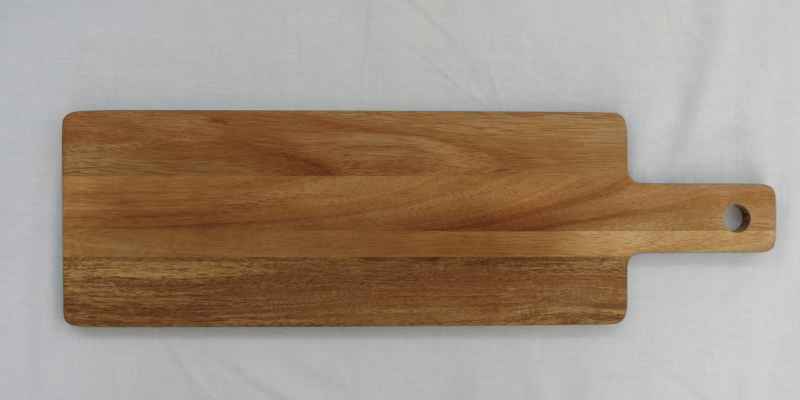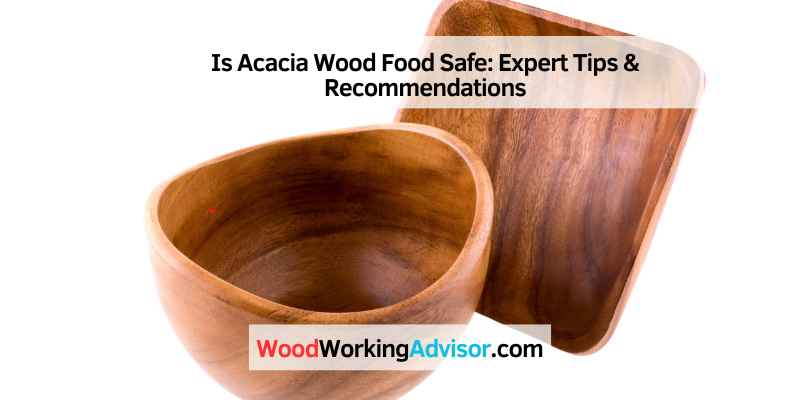Yes, acacia wood is food safe as it contains antibacterial properties and is resistant to water, scratching, and scraping. Acacia wood is a durable and suitable material for cutting boards and other kitchen utensils.
Is Acacia Wood Food Safe
Acacia wood is a popular choice for kitchenware and serving boards due to its durability and natural resistance to water and bacteria. Let’s delve into the details to understand the suitability of acacia wood for food-related purposes.
Hardness And Water Resistance
Acacia wood stands as one of the hardest woods available in the market. Its hardness surpasses the likes of maple and oak, making it an excellent choice for cutting boards and kitchen utensils. Moreover, this robust hardwood naturally resists water, making it less prone to deterioration due to moisture. Unlike plastic cutting boards, acacia wood possesses antibacterial properties, offering a hygienic food preparation surface.
Potential Downsides Of Acacia Wood
While acacia wood boasts impressive durability and water resistance, it is essential to be mindful of certain downsides. When exposed to direct sunlight, acacia wood may soften, dry out, or potentially crack or warp. Additionally, it is vulnerable to damage from substances such as alcohol, perfumes, silicone-based products, and cleaning solutions with drying agents.
Acacia Wood Chopping Board Care & Maintenance
Acacia wood is considered food-safe for cutting boards due to its natural antibacterial properties and resistance to scratching and water. It is a durable and reliable material for regular kitchen use, making it a popular choice for chopping board care and maintenance.
Durability In Regular Use
Acacia wood is known for its durability, making it an excellent choice for a chopping board that will withstand regular use in the kitchen. Unlike plastic cutting boards, which can easily scrape and scratch, acacia wood is resistant to such damage. Its natural hardness makes it a reliable option for chopping, cutting, and slicing various types of food.
Vulnerability To Sunlight And Certain Substances
However, it’s important to note that acacia wood is vulnerable to sunlight and certain substances. When exposed to direct sunlight, the wood tends to soften and can dry out, crack, or warp over time. Therefore, it is advisable to avoid prolonged exposure to sunlight when using or storing acacia wood chopping boards.
In addition, certain substances can also cause damage to acacia wood. Alcohol, perfumes, silicone-based products, and cleaning solutions with drying agents should be kept away from acacia wood chopping boards. These substances can lead to discoloration, stains, or even deterioration of the wood’s surface.
To ensure the longevity of your acacia wood chopping board, it is essential to follow a few simple care and maintenance steps:
- After each use, wash the board with warm water and mild dish soap. Avoid using harsh cleaners or abrasive scrubbers that can damage the wood.
- Dry the board thoroughly with a clean towel and allow it to air dry completely before storing.
- Apply a food-safe mineral oil or a specialized wood conditioner to the board at regular intervals to maintain its natural moisture and prevent drying out.
- Avoid immersing the board in water or leaving it soaking to prevent warping or cracking.
- Store the chopping board in a dry and well-ventilated area to prevent exposure to excessive moisture.
By following these simple care instructions, you can ensure that your acacia wood chopping board remains in excellent condition and safe to use in your kitchen for years to come.
Food Safety Of Acacia Wood
Comparison With Other Woods
Acacia wood is harder than maple and oak, providing durability for kitchen use.
Suitability For Hot Food
Acacia wood is safe for putting hot food on due to its heat resistance properties.
Best Wood For Chopping Board
Close Grained Hardwood Recommendation
Cutting boards made of close grained hardwood (such as Acacia wood which is used to manufacture Wild Wood boards) are the best boards to use. Bacteria found on these boards do not multiply, and gradually die, making it safe for kitchen use.
Bacterial Multiplication On Wooden Boards
Wooden cutting boards, particularly those made from close grained hardwood like Acacia wood, actively inhibit bacterial multiplication. This natural property helps in maintaining a hygienic chopping surface and ensures the safety of your food.
Acacia Wood For Cutting Board
Acacia wood is food safe and ideal for cutting boards as it is naturally resistant to water and has antibacterial properties. It is a durable hardwood that is less prone to scratching, making it suitable for regular kitchen use. Plus, acacia wood cutting boards do not harbor bacteria, providing a safe surface for food preparation.
Considered Safe For Use
Acacia wood is widely regarded as safe for use in cutting boards. Being one of the hardest woods available, it offers a sturdy and durable surface for chopping, slicing, and dicing. Unlike plastic cutting boards, acacia wood contains natural antibacterial properties that help prevent the growth of harmful bacteria.
With its natural resistance to water, acacia wood is less likely to absorb moisture, reducing the risk of warping, cracking, or splitting over time. This makes it an ideal choice for regular use in the kitchen.
Comparison With Walnut Wood
When it comes to comparing acacia wood with walnut wood for cutting boards, both options have their own set of pros and cons.
Acacia Wood:
- Offers exceptional durability and resistance to moisture
- Contains natural antibacterial properties
- Less prone to scraping or scratches
Walnut Wood:
- Chemically resistant to fungi and bacteria
- Considered food safe
Both acacia and walnut wood can be suitable choices for cutting boards. However, the individual preferences and requirements of the user may play a role in determining which one is a better fit for their specific needs.
Health Risks And Toxicity
When considering the safety of acacia wood for food use, it is crucial to assess the potential health risks and toxicity associated with this material.
Species Of Acacia Wood Concerns
Not all species of acacia wood are suitable for food contact due to variations in their chemical composition and potential toxicity.
Toxicity Of Acacia Confusa Seeds
Acacia confusa seeds are known to contain certain compounds that can be toxic if ingested, posing a health risk for individuals.
Cleaning And Maintenance

Cleaning Process For Acacia Wood
When cleaning acacia wood, use a mild soap and warm water solution to wipe down the surface. Avoid harsh chemicals to maintain the wood’s natural properties.
Comparison With Other Wood Types
Acacia wood is more resistant to water damage compared to softer woods like pine or cedar. Its antibacterial properties make it a safer choice for food-related items.
Popularity Of Acacia Wood For Cutting Boards
Acacia wood is a popular choice for cutting boards due to its natural resistance to water and antibacterial properties. It’s harder than maple and oak, making it durable and less prone to scratching. However, exposure to direct sunlight can cause it to soften and warp, and certain substances can damage it.
Acacia wood is generally considered safe for use in cutting boards, as it is a hardwood known for its durability and resistance to moisture.
Trend And Popularity Of Acacia Wood
Acacia wood has gained significant popularity as a material for cutting boards in recent years. With its beautiful natural grain, durability, and food-safe properties, it is no wonder that acacia wood has become a top choice for many home cooks and professional chefs alike.
Historical Use And Advantages
Acacia wood has been used for centuries in various cultures for its incredible strength and versatility. Historically, it has been used to construct furniture, tools, and even musical instruments. The unique properties of acacia wood make it an ideal material for cutting boards.
Some key advantages of using acacia wood for cutting boards include:
1. Durability: Acacia wood is one of the hardest woods available, making it highly resistant to scratches and wear. This means that your acacia wood cutting board will last for years, even with regular use.
2. Water Resistance: Unlike other types of wood, acacia is naturally resistant to water. This makes it less prone to warping or cracking when exposed to moisture, such as when washing your cutting board.
3. Antibacterial Properties: Acacia wood contains natural antibacterial properties, making it a hygienic choice for cutting boards. Studies have shown that bacteria are less likely to thrive and multiply on wooden cutting boards compared to plastic ones.
4. Aesthetic Appeal: Acacia wood’s beautiful natural patterns and warm tones add a touch of elegance to any kitchen. Its unique grain patterns make each cutting board a work of art in itself.
In conclusion, the trend and popularity of acacia wood for cutting boards can be attributed to its durability, water resistance, antibacterial properties, and aesthetic appeal. Whether you are a professional chef or a home cook, an acacia wood cutting board is a stylish and practical addition to your kitchen arsenal.
Frequently Asked Questions For Is Acacia Wood Food Safe
Is Acacia Wood Safe For Cutting Boards?
Acacia wood is safe for cutting boards due to its hardness, water resistance, and antibacterial properties. It is less prone to scratching and ideal for regular use. However, it may soften and crack when exposed to direct sunlight and can be damaged by certain substances.
Overall, acacia wood is considered food safe and durable.
What Is The Downside Of Acacia Wood?
Acacia wood can soften, crack, or warp in direct sunlight and may be damaged by certain substances.
What Is The Most Food Safe Wood?
Acacia wood is the most food-safe choice due to its hardness, water resistance, antibacterial properties, and durability.
Can You Put Hot Food On Acacia Wood?
Yes, you can put hot food on acacia wood. Acacia wood is resistant to water and has antibacterial properties, making it safe for use with hot food. However, it is important to note that extreme heat can damage the wood over time.
Conclusion
Acacia wood is a popular choice for cutting boards due to its durability and resistance to water. It also contains natural antibacterial properties, making it a safe option for kitchen use. However, it is important to note that acacia wood can soften and dry out in direct sunlight, so proper care and maintenance are essential.
When used correctly, acacia wood cutting boards are a great choice for any home cook looking for a food-safe option that is both practical and aesthetically pleasing.


